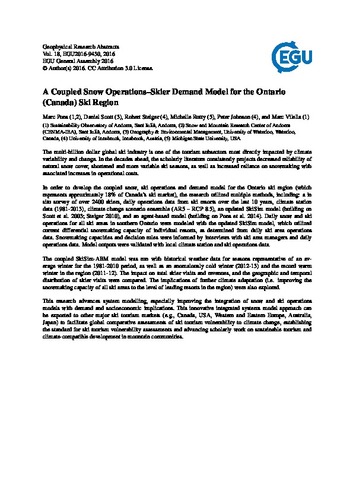| dc.contributor.author | Pons, Marc | |
| dc.contributor.author | Scott, Daniel | |
| dc.contributor.author | Steiger, Robert | |
| dc.contributor.author | Rutty, Michelle | |
| dc.contributor.author | Johnson, Peter | |
| dc.contributor.author | Vilella, Marc | |
| dc.date.accessioned | 2021-01-25 22:24:15 (GMT) | |
| dc.date.available | 2021-01-25 22:24:15 (GMT) | |
| dc.date.issued | 2016-04-01 | |
| dc.identifier.uri | http://adsabs.harvard.edu/abs/2016EGUGA..18.9430P | |
| dc.identifier.uri | http://hdl.handle.net/10012/16728 | |
| dc.description.abstract | The multi-billion dollar global ski industry is one of the tourism subsectors most directly impacted by climate variability and change. In the decades ahead, the scholarly literature consistently projects decreased reliability of natural snow cover, shortened and more variable ski seasons, as well as increased reliance on snowmaking with associated increases in operational costs. In order to develop the coupled snow, ski operations and demand model for the Ontario ski region (which represents approximately 18% of Canada's ski market), the research utilized multiple methods, including: a in situ survey of over 2400 skiers, daily operations data from ski resorts over the last 10 years, climate station data (1981-2013), climate change scenario ensemble (AR5 - RCP 8.5), an updated SkiSim model (building on Scott et al. 2003; Steiger 2010), and an agent-based model (building on Pons et al. 2014). Daily snow and ski operations for all ski areas in southern Ontario were modeled with the updated SkiSim model, which utilized current differential snowmaking capacity of individual resorts, as determined from daily ski area operations data. Snowmaking capacities and decision rules were informed by interviews with ski area managers and daily operations data. Model outputs were validated with local climate station and ski operations data. The coupled SkiSim-ABM model was run with historical weather data for seasons representative of an average winter for the 1981-2010 period, as well as an anomalously cold winter (2012-13) and the record warm winter in the region (2011-12). The impact on total skier visits and revenues, and the geographic and temporal distribution of skier visits were compared. The implications of further climate adaptation (i.e., improving the snowmaking capacity of all ski areas to the level of leading resorts in the region) were also explored. This research advances system modelling, especially improving the integration of snow and ski operations models with demand and socioeconomic implications. This innovative integrated systems model approach can be exported to other major ski tourism markets (e.g., Canada, USA, Western and Eastern Europe, Australia, Japan) to facilitate global comparative assessments of ski tourism vulnerability to climate change, establishing the standard for ski tourism vulnerability assessments and advancing scholarly work on sustainable tourism and climate-compatible development in mountain communities. | en |
| dc.language.iso | en | en |
| dc.publisher | EGU General Assembly Conference Abstracts | en |
| dc.relation.ispartofseries | Geophysical Research Abstracts; | |
| dc.rights | Attribution 4.0 International | * |
| dc.rights.uri | http://creativecommons.org/licenses/by/4.0/ | * |
| dc.title | A Coupled Snow Operations-Skier Demand Model for the Ontario (Canada) Ski Region | en |
| dc.type | Extended Abstract | en |
| dcterms.bibliographicCitation | Pons, M., Scott, D., Steiger, R., Rutty, M., Johnson, P., & Vilella, M. (2016, April). A Coupled Snow Operations-Skier Demand Model for the Ontario (Canada) Ski Region. In EGU General Assembly Conference Abstracts (pp. EPSC2016-9430). | en |
| uws.contributor.affiliation1 | Faculty of Environment | en |
| uws.contributor.affiliation2 | Geography and Environmental Management | en |
| uws.typeOfResource | Text | en |
| uws.peerReviewStatus | Reviewed | en |
| uws.scholarLevel | Faculty | en |


